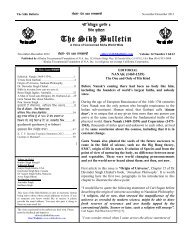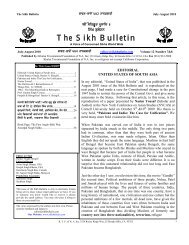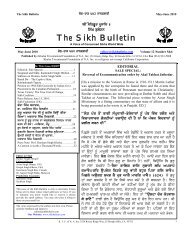Selected Editorials - The Sikh Bulletin
Selected Editorials - The Sikh Bulletin
Selected Editorials - The Sikh Bulletin
You also want an ePaper? Increase the reach of your titles
YUMPU automatically turns print PDFs into web optimized ePapers that Google loves.
Two questions arise:<br />
1. Why the distinction between daughter and son when Gurbani gives both sexes an equal<br />
status<br />
2. If the entire humanity is child of one God then why discriminate in the name of religion<br />
which is man made<br />
It is logical to assume from the above quotes that a <strong>Sikh</strong> can be recognized by his appearance alone. A<br />
key determinant of that is unshorn hair. Yet there is no mention of the requirement for a <strong>Sikh</strong> to keep<br />
unshorn hair in Guru Granth Sahib. If anything, it says that it makes no difference to the creator whether<br />
we keep long hair or a bald head; what counts are our deeds, our conduct in our daily lives.<br />
kbIr pRIiq eyk isAuN kIey afn duibDf jfie]<br />
BfvY lFby kys kru BfvY Grir muzfie] GGS p. 1365.<br />
If the Gurus kept unshorn hair, covered with a turban, they were simply following one of the then<br />
prevalent Indian customs that also included completely shorn and partially shorn hair. It were Hindus and<br />
Muslims, in various forms of appearance, who came to listen to the Gurus and none was barred based on<br />
their appearance or for any other reason.<br />
Mardana, a Muslim, perhaps should be considered first among Guru Nanak’s <strong>Sikh</strong>s because he spent his<br />
entire adult life in Guru’s company and provided music for Guru’s hymns. Today his descendants are not<br />
allowed to perform kirtan at Darbar Sahib or any other Gurdwara.<br />
<strong>The</strong> requirement of keeping unshorn hair started with the tenth Nanak, Guru Gobind Singh, but only for<br />
those who volunteered to partake ‘khande-di-pahul’ and alongwith unshorn hair they were also required<br />
to carry four more articles of faith. At no time were the non-pahuldhari <strong>Sikh</strong>s considered any lesser.<br />
In time the children of pahuldhari <strong>Sikh</strong>s, and many others, started keeping long hair without taking pahul,<br />
and now we are at a point where non-kesadhari <strong>Sikh</strong> is not just looked down upon but not even<br />
considered a <strong>Sikh</strong>. <strong>The</strong>re is one kesadhari and pahuldhari sect among us that does not consider as <strong>Sikh</strong>s<br />
even those kesadhari and pahuldhari <strong>Sikh</strong>s who have not been baptized by their ritual and do not agree<br />
with their interpretation of Gurbani. Members of this group have resorted to violence in UK, Canada and<br />
USA to stop missionaries trained in Gurmat Gian Colleges from performing katha in our gurdwaras.<br />
It is an interesting coincidence that both terms, <strong>Sikh</strong> and Taliban, literally mean the same thing, ‘the<br />
student’. Unfortunately, we have seen the emergence of <strong>Sikh</strong> Taliban in the Diaspora. We should never<br />
forget that a <strong>Sikh</strong> is one who lives by the teachings enshrined in Guru Granth Sahib that embodies<br />
the philosophy of Guru Nanak. Gurus lived their lives as they preached. <strong>The</strong>re was no difference in<br />
their kathani and karni and they did not expect anything less from their <strong>Sikh</strong>s.<br />
It would be appropriate here to quote from my May-June 2012 <strong>Sikh</strong> <strong>Bulletin</strong> editorial:<br />
“Here I would like to confess to my personal belief that might be considered a blasphemy and offend<br />
most people, even those who know me well. That is that Guru Nanak did not initiate another religion.<br />
<strong>The</strong>re were too many religions and divisions among them in his time as is the case today. Today he will<br />
surely say that ‘I am neither a Hindu nor a Muslim; neither a <strong>Sikh</strong> nor a Christian’. He showed<br />
mankind a path to life and living. <strong>The</strong> tragedy is that ‘well meaning people’, which would be 99.9% of<br />
us all, have turned it into yet another divisive and suffocating faith.”<br />
Several days after this issue of the <strong>Sikh</strong> <strong>Bulletin</strong> was released on the internet, Dr. Harbans Lal sent me an<br />
article for publications about the findings of Syed Mushtaq Hussain Mirpuri, a Kashmiri Muslim,<br />
72
















